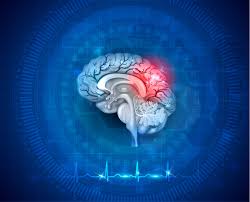Stroke
Stroke is a serious brain condition in which the blood vessels present in brain ruptures or bleeds or when there is a blockage in the blood supply of the brain. This rupture or blockage causes sudden death of brain cells or neurones. A stroke can cause permanent brain damage, long-term disability or even death. It is categorised in mental illness. Every year, more than 795,000 people in the United States have a stroke. About 610,000 of these are first or new strokes. About 185,000 strokes—nearly 1 in 4—are in people who have had a previous stroke. About 87% of all strokes are ischemic strokes, in which blood flow to the brain is blocked and not only United States is affected by stroke problem, there is a drastic change in the cases of stroke every year all over the world.
Types of Stroke
1) Ischemic stroke: Most of the brain strokes are Ischemic stroke. It is the most common type and contributes to 80% of brain strokes. An Ischemic stroke occurs when there is a blood clot or any other particle block the blood flow in the brain. Fatty deposites like plaque can also cause blockages in the blood flow.
Ischemic stroke is further divide between two types of stroke:
A) Thrombotic Stroke: It is the most common type of Ischemic stroke. A blood clot forms inside the damaged or disease blood vessel in the brain resulting from cholesterol condition called Atherosclerosis (Cholesterol containing deposits called plaque) and cause blocking of blood flow. This type of stroke usually seen in the old age peoples. A person with high cholesterol or having any diabetic condition can also have the risk of Thrombotic Stroke.
B) Embolic Stroke: It is caused when a clot or cholesterol deposits called plague formed in one of the blood vessel (Arteries) leading to the Brain or in the heart is, passed through the blood stream and lodges in narrower brain arteries. The blood supply is cut off from the brain due to the clogged vessels. When arteries is blocked the brain can't produce the energy needs to function. These brain cell will begin to die of if the blockage last for more than a few minutes.
2) Hemorrhagic stroke: The cases of Hemorrhagic stroke are less than Ischemic stroke and it contribute to 20% of brain strokes. A Hemorrhagic stroke is occur when blood vessel (Artery) in the brain leak or ruptures. The leak blood from the rupture artery put so much pressure on brain cell and causes damage to them. It only occur when there is a rupture of weekend blood vessels.
Hemorrhagic stroke further divide between two types of stroke:
A) Intracerebral haemorage: It is a bleeding condition that occurs within the brain tissue. Most common cause is due to changes in the arteries caused by long term hypertension. Hypertension is one of the main cause of Intracerebral hemorrhage. People above the age of 55 having higher risk of getting inter cerebral hemorrhage and it is often more common in men.
B) Subarachnoid haemorage: In this condition bleeding occurs in the space between the brain and the skull that protects the brain. It mainly occurs when there is a weak blood vessel on the surface of brain bursts or leaks then the blood from the rupture blood vessel is built up around the brain and inside the skull, increasing pressure on the brain. This can cause serious brain damage, long term disability or any other kind of life long complications.
3) Transient Ischemic Attack: Transient Ischemic attack is a warning sign of possible future strokes and it is treated as a neurological emergency. It is also known as ''mini-stroke''. It is different from the other types of stroke because blood flow from the brain is blocked for only a short period of time, usually about 1 to 5 minutes. There are some symptoms of TIA which include difficulty in speaking or understanding others, less or bluring vision in one eye and loss of strength.
Symptoms of Stroke
1. Trouble in saying something and also can't understand what others are saying.
2. Started feeling numbness and weakness on one side of the body.
3. Trouble in walking.
4. Can't maintain balance of the body.
5. Sudden headache.
Causes of Stroke
1. Blocked blood vessel (Artery) called Ischemic stroke.
2. Leakage aur bursting of blood vessel (Artery) refers to Hemorrhagic stroke.
3. The third causes Transient Ischemic Attack (TIA), it is a temporary disruption of blood flow to the brain.
Risk factors for Stroke
1) Smoking: It is one of the main risk factor for stroke. Consuming cigarets not only damages your lungs but it also affect your brain health.
If you smoke, then start finding ways to quit it and if you don't smoke then don't start it.
2) Hypertension: It is also another important risk factor for stroke. Most importantly high blood pressure in adults and old age people can be dangerous for themselves. A blood pressure of 140/90 or above is considered to be high and cause you stroke problem. The normal blood pressure range should be 120/80 or below.
3) High Cholesterol (Hyperlipidemia): It increases the risk of stroke especially Ischemic stroke. You should timely check your cholesterol level to reduce the risk of stroke and should eat low cholesterol diet for a healthy living.
4) Consumption of alcohol and illegal substance like drugs: You should limit your consumption level of Alcohol or quit the habit of Alcohol to prevent yourself from Stroke.
Street drugs, such as cocaine, crack, marijuana etc. have increases the risk of stroke. They directly affect the blood vessels (Arteries) in the brain and causes stroke. Some drugs also block the blood vessels the heart.
5) Old or previous stroke: If previously, you already had a stroke then, risk of getting second one is very high.







Comments
Post a Comment